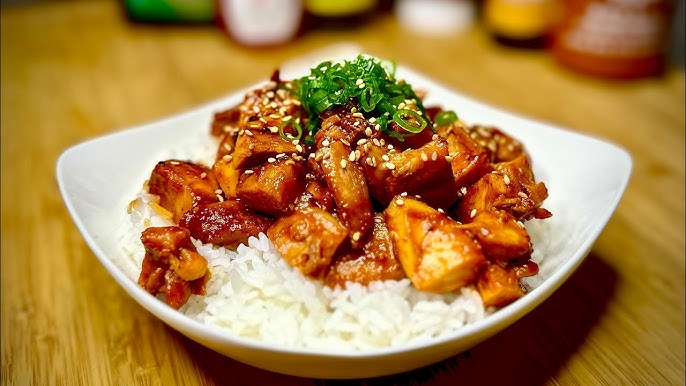Chicken Korean Barbecue Recipe: If you’ve ever been to a Korean barbecue restaurant, you know the thrill of cooking meat right at the table, pairing it with fresh veggies, and enjoying it with a variety of sauces. Korean barbecue, often called “K-BBQ,” is more than just food—it’s an experience. While beef and pork are the most popular proteins, chicken has quickly gained attention for its lighter taste and ability to absorb rich marinades beautifully.
Chicken Korean BBQ blends sweet, savory, and spicy flavors in a way that’s satisfying yet not too heavy. It’s perfect for family dinners, weekend gatherings, or even a solo cooking adventure when you want a flavorful dish without spending hours in the kitchen.
What Makes Korean Barbecue Special?
Unlike traditional Western barbecue, Korean BBQ isn’t just about smoky flavors. It’s about balance. You’ll taste sweetness from sugar or honey, savoriness from soy sauce, and heat from chili paste (gochujang). The meat is usually marinated in advance, ensuring that every bite bursts with flavor. Plus, the dining experience itself—sharing food, grilling at the table, and mixing in fresh side dishes—makes it truly special.
Why Choose Chicken for Korean BBQ?
Chicken is leaner than pork or beef, making it a healthier option. It also soaks up marinades faster, which means you don’t need to wait overnight for flavors to develop (though it tastes even better if you do). Chicken thighs are juicy and forgiving to cook, while chicken breast is a lighter option for those watching calories. If you want something easy, flavorful, and satisfying, chicken is your best bet for Korean barbecue at home.
Ingredients You’ll Need
Before you start, gather all the ingredients so you don’t miss anything while cooking. A good Korean BBQ chicken depends heavily on the marinade, so stock up on authentic Asian pantry staples.
Essential Chicken Cuts for BBQ
- Chicken thighs (skinless and boneless, best for juicy flavor)
- Chicken breasts (leaner option but slightly less juicy)
- Chicken drumsticks (great for grilling, but require longer cooking)
Pro tip: Go for chicken thighs if you’re a beginner—they’re hard to overcook and always stay tender.
Core Marinade Ingredients
Here’s the heart of your Korean BBQ chicken recipe:
- Soy sauce – for deep umami flavor
- Gochujang (Korean chili paste) – for that signature spicy kick
- Sesame oil – nutty and aromatic
- Garlic (minced) – a must-have in Korean cooking
- Ginger (freshly grated) – adds warmth and brightness
- Brown sugar or honey – balances spice with sweetness
- Rice vinegar or mirin – for slight tanginess
- Green onions – chopped, for freshness
- Sesame seeds – optional but perfect for garnish
Optional Garnishes and Side Dishes
- Kimchi (fermented cabbage)
- Lettuce leaves (for wrapping chicken pieces)
- Cucumber slices or pickled radish
- Extra dipping sauces (like ssamjang or soy-sesame dip)
With these ingredients, you’re ready to bring authentic Korean flavors to your kitchen.
Preparing the Chicken
The preparation stage is where flavor magic begins. Korean BBQ chicken isn’t just about grilling meat—it’s about how well you marinate and prepare it.
Cleaning and Cutting the Chicken
Start by rinsing the chicken under cold water and patting it dry with paper towels. Cut chicken thighs or breasts into medium-sized chunks or thin slices. Smaller pieces absorb marinade faster and cook evenly. Avoid cutting pieces too small, though—they can dry out quickly on the grill.
Marinating Techniques for Maximum Flavor
- Use a large bowl or resealable plastic bag to combine chicken and marinade.
- Massage the marinade into the chicken to ensure every piece is coated.
- For an extra tender texture, add a teaspoon of pear puree or grated apple—this is a traditional Korean trick to tenderize meat.
How Long Should You Marinate?
- Quick option: 1 hour in the fridge (flavorful enough if you’re short on time).
- Best option: 6–8 hours for maximum absorption.
- Overnight: Perfect for next-day grilling.
The longer you marinate, the richer the flavor gets. Just remember not to exceed 24 hours, or the texture may change.
Cooking Methods for Chicken Korean BBQ
Now comes the fun part—cooking. You can stick to traditional methods or adapt depending on the equipment you have at home.
Traditional Charcoal Grilling
Charcoal grilling is the most authentic way to cook Korean BBQ chicken. The smoky aroma infuses the meat with depth that’s hard to beat. Place chicken pieces over medium heat and grill for 5–7 minutes per side until caramelized and fully cooked.
Indoor Pan or Grill Cooking
Don’t have outdoor space? A stovetop grill pan or cast-iron skillet works just as well. Heat the pan, lightly oil it, and cook chicken until golden and cooked through. This method is quicker and easier for everyday cooking.
Oven-Baked Korean BBQ Chicken Alternative
If you want a fuss-free method, use your oven. Preheat to 400°F (200°C), line a baking sheet with foil, and bake chicken for 20–25 minutes, flipping halfway. You won’t get the same smokiness as grilling, but it’s still delicious and convenient.
Step-by-Step Guide to Making Chicken Korean BBQ
This is where we put everything together. Follow these steps carefully, and you’ll have restaurant-quality Korean BBQ chicken at home.
Step 1 – Preparing the Marinade
In a large bowl, mix soy sauce, gochujang, sesame oil, garlic, ginger, sugar, and vinegar. Stir well until smooth.
Step 2 – Marinating the Chicken
Add the chicken pieces to the marinade, coat thoroughly, and cover. Let it rest in the refrigerator for at least 1 hour, ideally overnight.
Step 3 – Cooking the Chicken
Grill, pan-fry, or bake the marinated chicken until fully cooked. Internal temperature should reach 165°F (74°C).
Step 4 – Serving the BBQ Chicken
Sprinkle sesame seeds and chopped green onions on top. Serve with lettuce wraps, kimchi, and dipping sauces for the full Korean BBQ experience.
Perfect Side Dishes to Serve with Korean BBQ
One of the best parts about Korean barbecue is that the meal isn’t just about the meat. The experience shines when paired with fresh, tangy, and savory side dishes, also known as banchan. These sides are served in small portions and placed at the center of the table for everyone to share. They not only enhance the flavors of the grilled chicken but also make the entire dining experience more vibrant and balanced.
Classic Korean Side Dishes (Banchan)
- Kimchi – This fermented cabbage dish is the king of Korean cuisine. Spicy, tangy, and packed with probiotics, it cuts through the richness of the chicken.
- Japchae – Sweet potato glass noodles stir-fried with vegetables. It’s slightly sweet, chewy, and makes a wonderful complement to grilled meat.
- Korean Potato Salad – Creamy yet lighter than Western potato salad, often mixed with cucumbers and apples for freshness.
- Pickled Radish – Crunchy, sweet, and sour; it refreshes your palate between bites of smoky chicken.
Each of these banchan has its own flavor profile, making the meal diverse and exciting.
Fresh Vegetables and Wraps
Korean barbecue isn’t complete without ssam (wraps). These are simple but transformative:
- Use lettuce leaves or perilla leaves as wraps.
- Add a piece of chicken, a slice of garlic, rice, and a dab of sauce.
- Roll it up and eat it in one bite.
This method not only balances the richness of the chicken but also adds crunch and freshness to every mouthful.
Korean BBQ Sauces and Dips
No Korean BBQ feast is complete without the dipping sauces. Two must-haves are:
- Ssamjang – A thick, savory paste made from soybean paste, chili paste, garlic, sesame oil, and sugar.
- Sesame-Soy Dip – A simple mix of soy sauce, sesame oil, sesame seeds, and chopped green onions.
These sauces add an extra layer of depth and make every bite customizable to your taste.
Tips for the Best Korean BBQ Experience
Cooking delicious chicken is one thing, but enjoying the Korean BBQ experience is about creating balance and fun at the table. Here are some pro tips to elevate your meal.
Balancing Sweet, Savory, and Spicy Flavors
Korean food is all about harmony. When preparing the marinade, make sure none of the elements overpower the others. For example:
- Too much sugar can make it cloyingly sweet.
- Too much chili paste may overwhelm the natural taste of the chicken.
- The right mix makes the chicken flavorful, not heavy.
A good rule of thumb: taste the marinade before adding the chicken. Adjust saltiness, sweetness, or spice according to your liking.
Avoiding Common Cooking Mistakes
- Overcooking chicken: Always check the internal temperature (165°F / 74°C). Juicy chicken is key.
- Using too much marinade on the grill: Excess liquid causes flare-ups and burns the chicken. Shake off extra marinade before cooking.
- Not preheating the grill or pan: A hot surface ensures caramelization and prevents sticking.
These small adjustments can make the difference between average and mouthwatering barbecue.
Presentation and Serving Tips
Korean food is about sharing, so present it in a way that invites everyone to dig in:
- Arrange grilled chicken on a platter, sprinkle sesame seeds, and garnish with green onions.
- Serve banchan in small bowls spread across the table.
- Place sauces in dipping bowls for easy access.
- Keep lettuce leaves stacked neatly for wrapping.
Eating becomes interactive, fun, and much closer to the authentic Korean barbecue experience.
Health Benefits of Chicken Korean BBQ
Yes, this dish is incredibly tasty—but the good news is, it’s also healthy when prepared the right way.
Nutritional Value of Chicken
Chicken is one of the leanest sources of protein available. Here’s why it’s a great choice:
- High in protein, which supports muscle repair and growth.
- Lower in saturated fat compared to red meats.
- Rich in essential vitamins like B6 and niacin, which boost energy metabolism.
When cooked without too much oil, chicken becomes a nutritious protein that fits into almost any diet.
Benefits of Korean Flavors and Ingredients
Korean marinades and side dishes also offer health perks:
- Garlic & ginger – Natural anti-inflammatory properties and immune boosters.
- Gochujang – Contains capsaicin, which may boost metabolism.
- Kimchi & fermented dishes – Great for gut health and digestion.
- Vegetable-based sides – Add fiber, vitamins, and minerals to your meal.
So, not only does chicken Korean BBQ taste incredible, but it also supports a balanced diet filled with nutrients.
Variations of Chicken Korean BBQ
One of the beauties of this dish is its versatility. You can adapt the flavors to suit your taste or to bring something new to the table.
Spicy Chicken Korean BBQ
For those who love extra heat, double the amount of gochujang and add crushed chili flakes. This version pairs beautifully with cooling side dishes like cucumber salad.
Honey Garlic Korean BBQ Chicken
If you prefer sweeter flavors, replace part of the sugar with honey and add extra garlic. The result is sticky, caramelized chicken with a sweet and savory punch.
Gochujang BBQ Chicken
For a bold, deeply flavored dish, let gochujang take center stage. Use a generous spoonful in the marinade and brush extra sauce onto the chicken while grilling. This variation is closest to the classic fiery Korean BBQ chicken you’d find at a restaurant.
FAQs about Chicken Korean Barbecue Recipe
1. Can I make Korean BBQ without a grill?
Yes! You can use a cast-iron pan, stovetop grill pan, or even bake the chicken in the oven. While you won’t get the smoky flavor of charcoal, the marinade ensures it’s still delicious.
2. How long should chicken be cooked for Korean BBQ?
Cook chicken until it reaches an internal temperature of 165°F (74°C). Typically, this takes 5–7 minutes per side on the grill or 20–25 minutes in the oven.
3. What’s the best substitute for gochujang?
If you can’t find gochujang, mix miso paste or soy sauce with chili flakes and a bit of honey. It won’t be identical but will give you a similar balance of savory, spicy, and sweet.
4. Can I prepare the marinade ahead of time?
Absolutely. The marinade can be prepared 2–3 days in advance and stored in the fridge. Just give it a quick stir before using.
5. What’s the best way to store leftovers?
Store leftover chicken in an airtight container in the refrigerator for up to 3 days. To reheat, use a skillet or oven instead of a microwave to keep the chicken juicy.
Conclusion
Making Chicken Korean Barbecue at home may sound intimidating, but with the right marinade, cooking method, and side dishes, you can easily recreate the authentic K-BBQ experience in your kitchen. From the smoky, flavorful chicken to the fresh wraps and colorful side dishes, every bite offers a balance of sweet, savory, and spicy flavors that will make you want to cook it again and again.
So, next time you crave something different for dinner, skip the takeout—fire up your grill or stovetop, gather some lettuce wraps, and enjoy your very own Korean barbecue feast at home.



